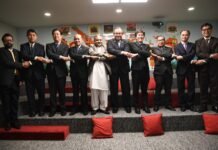Beijing, 11 August 2022 (TDI): The Pakistan Embassy in China presented a documentary on the artistic beauty, splendor, and grandeur of Mughal architecture in Pakistan. The embassy tweeted the documentary in a tweet.
We present to you the documentary on the artistic beauty splendor and grandeur of Mughal architecture in Pakistan. #75thPayKuchKhaas #PakistanAt75 @ForeignOfficePk @Marriyum_A @BBhuttoZardari pic.twitter.com/DVy66bCUKq
— Pakistan Embassy China (@PakinChina_) August 11, 2022
The documentary was featured to celebrate Pakistan’s glorious heritage, culture, and tradition, especially when the country is celebrating its 75 years of independence.
Mughal Architecture in Pakistan
Pakistani architecture connects with the architecture of the broader Indian subcontinent. Moreover, with the beginning of the Indus civilization for the first time in the area, which encompasses Pakistan, an advanced urban culture developed with large structural facilities, some of which still survive.
In addition, Mughal Architecture (1600-1800) in Pakistan encompasses the Naulakha pavilion in the Lahore Fort, Alamgiri Gate of the Lahore Fort, the Wazir Khan Mosque, Shalimar Gardens, Lahore, Akbari Sarai, Badshahi Mosque.
Mughal buildings have a uniform pattern of structure and character, including large bulbous domes, slender minarets at the corners, massive halls, large vaulted gateways, and delicate ornamentation, usually surrounded by gardens on all four sides.
Additionally, earlier, the Embassy of Pakistan in Beijing also launched two documentaries to showcase Pakistan’s cuisine and art & crafts.
Embassy of Pakistan Beijing today launched two documentaries to showcase the cuisine and art & crafts of Pakistan. #75thPayKuchKhaas #PakistanAt75 @ForeignOfficePk @Marriyum_A @BBhuttoZardari pic.twitter.com/gFmfx2xKRR
— Pakistan Embassy China (@PakinChina_) August 10, 2022
Pak-China Cultural Collaborations
The cultural exchanges between China and Pakistan have undergone a long history. Surprisingly, it started more than two thousand years ago.
Shortly after the founding of New China in 1949, the two countries began their diplomatic ties and have ever since maintained close and friendly cooperative relations in various fields like politics, the economy, and culture.
Moreover, the two countries’ governments signed The Cultural Cooperation Agreement on March 25, 1965, when the first executive program for the Agreement was also signed.
In the past half a decade, Chinese art troupes visited Pakistan many times, including folk song and dance troupe, traditional instrumental music troupe and acrobatic troupe, etc. Besides that, exchanges also took place in areas like painting, handicrafts, puppet shows, etc.
Lastly, cultural exchange between Pakistani and Chinese citizens increased after the launch of CPEC. Cooperation and understanding between the governments extended to collaboration and acceptance among the people.








